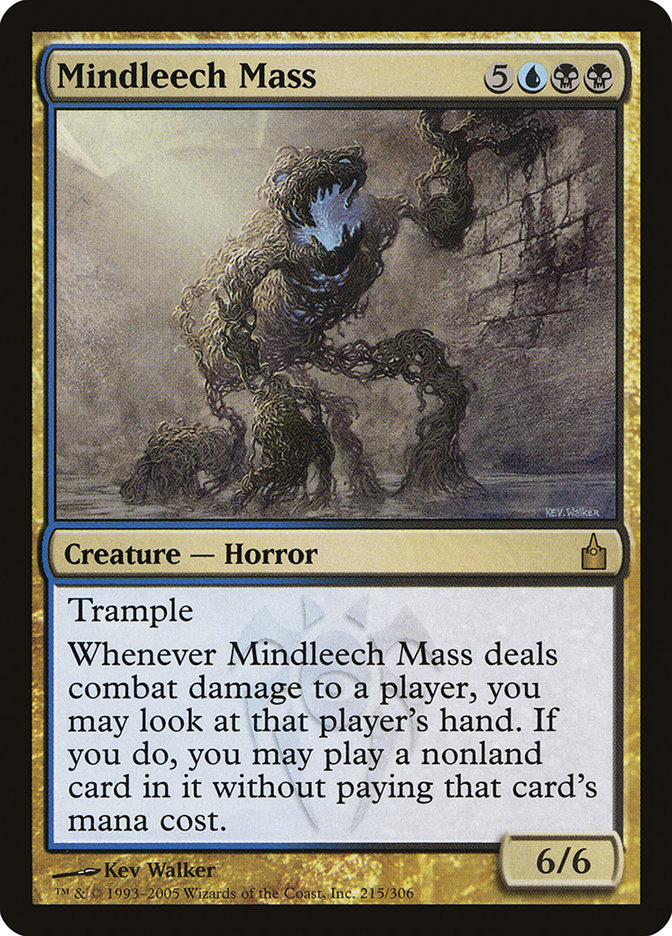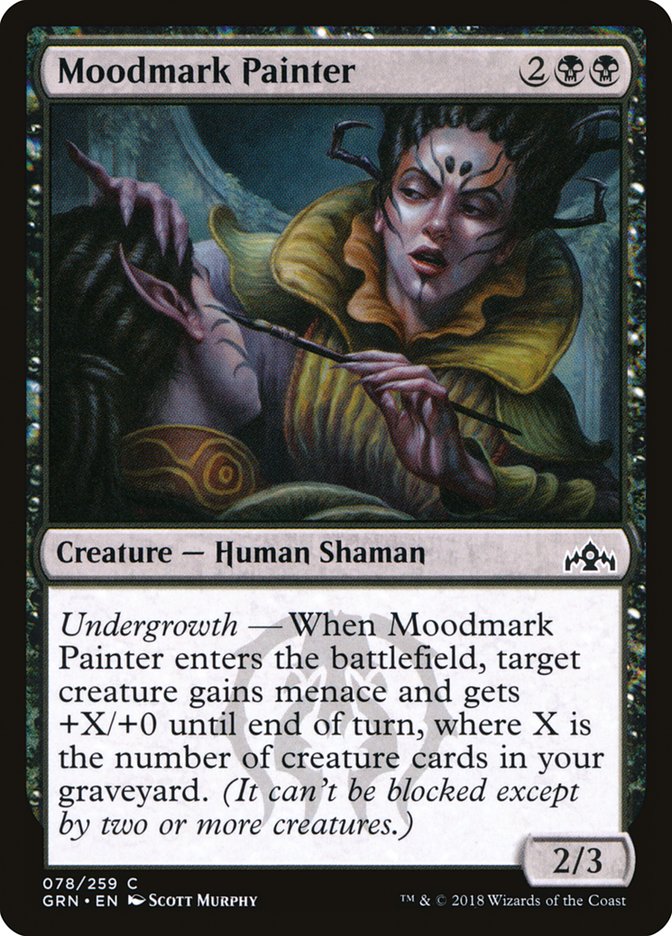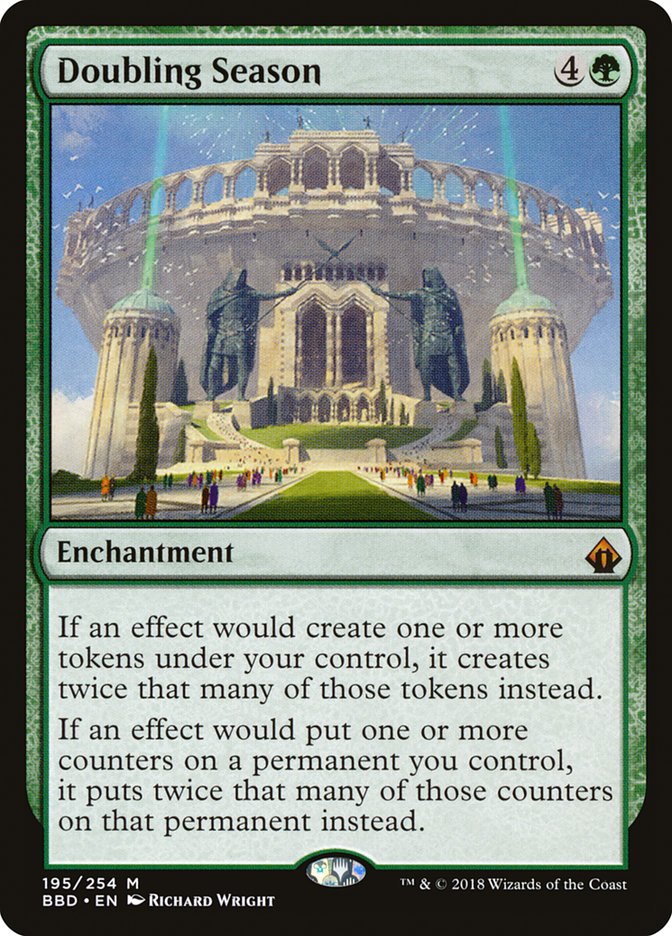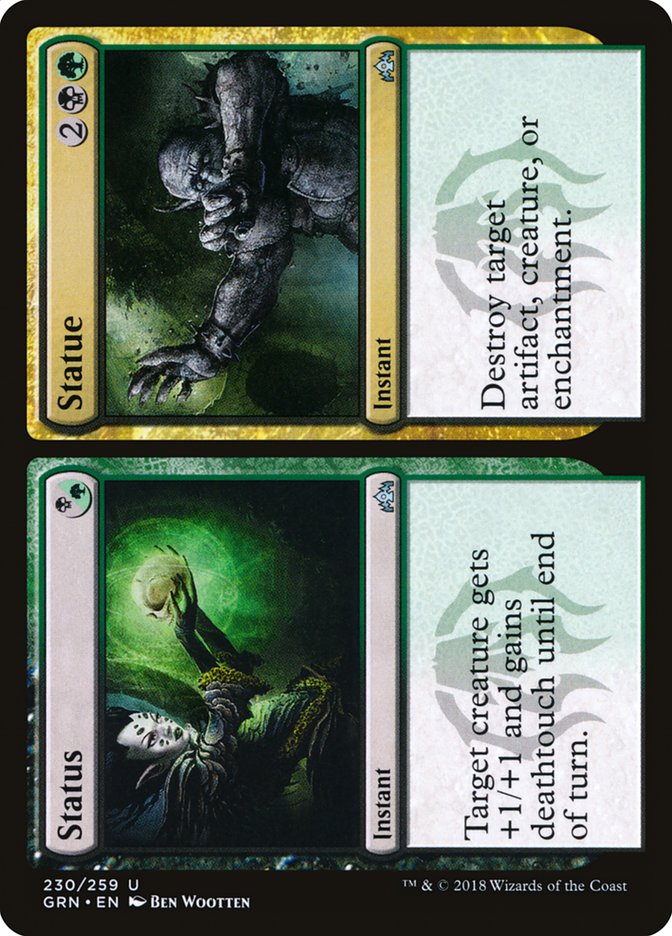Last week, Rules Manager Matt Tabak
offered his explanation
of the new and returning mechanics in Guilds of Ravnica. I
encourage you go watch and listen to the videos. Matt has a soothing and
entertaining voice. He speaks with an inflection that tells you a good joke
is not far away. Back to us, today we’re going to go over those mechanics
here and discuss their impact on Commander. Plus, we’ll take a look at some
freshly-previewed cards to see if they’ll be any good in the 100-card
format.
Surveil
The Dimir mechanic, surveil, is like scry, only better. It’s effectively
the same as scry, save instead of putting the cards on the bottom of your
library, you put them in the graveyard. The obvious twist here is that
instead of tossing away cards you don’t want, putting them into the
forgotten places in your library, you have the option of choosing things
that you want to put into the graveyard for later reuse.
If you’re using a mechanic for simple library manipulation (the legal kind,
not the mechanic’s grip kind), I’d suggest sticking with scry. If you want
to reanimate things or use Flashback cards (although it kind of defeats the
purpose of the Flashback spell to not cast it twice), then surveil will be
your jam. Graveyards are a huge resource in Commander, and there are any
number of reasons you’d want to fill yours. Wouldn’t it be sweet to surveil
2 and see one giant monster and one reanimation spell. Maybe they’re two
classic favorites like Zombify and Mindleech Mass.
Or something a little newer such as Razaketh, the Foul-Blooded. You can
also use surveil to fish for something to save your graveyard if need be,
like Kozilek, Butcher of Truth. Your graveyard is saucy, but you’re in a
tight spot because someone just dropped Bojuka Bog on your face. With the
trigger on the stack, use an instant with surveil, like the
already-previewed Unexplained Disappearance. Cross your fingers and hope
one of your Eldrazi is on top. Or increase your odds with cards like
Sensei’s Divining Top or Scroll Rack. Sure, it’s a long shot, but at least
you have a chance.
You might also use surveil to just fill up your graveyard, either without
the intention of bringing stuff out or using some of these things now and
reanimating/regrowing later. Apocalypse Demon cares about that count. If
you’re in Sultai, Boom Tube (that’s Lord of Extinction) loves meatier
yards. Most of the rest of the playable ones rely on creature cards in
graveyards, such as Revenant, Seed Guardian, Splinterfright, or Svogthos,
the Restless Tomb. We’ll talk about this more when we get to the
undergrowth mechanic. Cards with threshold also fit this bill. Without
going outside the bounds of U/B, you have cards like Stitch Together,
Possessed Aven, and Repentant Vampire. Add green for an old-timey favorite
and mainstay of my first Phelddagrif deck, Battlefield Scrounger. There’s
also Possessed Centaur and for those of you who would like some combo
potential, Krosan Restorer. Don’t dismiss Havengul Lich; it’s more fun to
cast stuff out of other graveyards, but I bet there are creatures in your
own to recast as well.
Also, let’s not forget dredge!
Actually, let’s forget dredge completely.
Jump-Start
Another new mechanic that has a whiff of an old one, in this case, some
hybrid of Flashback and retrace. As of this writing, the only card we’ve
seen is the one in Matt’s article, Sonic Assault (which, as of this
writing, weirdly doesn’t yet appear in the
Guilds of Ravnica
Card Image Gallery
). We don’t have much to go on at the moment regarding whether they’re all
relatively low cost spells or there are bigger, splashier ones, but there’s
still consideration about the mechanic itself.
Unlike retrace, which makes you discard a land (but then doesn’t exile the
card, hence the Flashback comparison), you can discard anything to
jump-start. Izzet isn’t really known for its graveyard shenanigans, so in
order to take advantage of the discard in the ways we’ve discussed, you’ll
likely have to add black. But there are other ways to enjoy what jump-start
does for you.
If that’s not your style, remember that Izzet has a commander like Tawnos,
Urza’s Apprentice, who likes artifacts. Blue also has one of the best lands
around for getting back your artifacts, Academy Ruins. There aren’t too
many cards that trigger on discarding cards, but there are things that like
you have to have stuff in the graveyard. Delirium (the mechanic, not the
otherwise awesome card) and spell mastery come to mind. More cards in your
graveyard can help transforming Search for Azcanta into Azcanta, the Sunken
Ruin or Jace, Vryn’s Prodigy into Jace, Telepath Unbound. More different
card types make Emrakul, the Promised End easier to cast. We’ll explore
more about this mechanic when we see more cards.
Undergrowth
As Matt mentions in his explanation, undergrowth cards will each work
differently, so we’ll need to pay attention when the cards come out. The
previewed one, Moodmark Painter, gains menace and gives a creature +X/+0
until end of turn, where X is the number of creature cards in your
graveyard. “Undergrowth abilities provide scaling effects that may start
small, but they can be dominating in the lategame,” Matt says. This gives
me no end of joy, because it’s one of the things that I mentioned to the
R&D folks that we’d like to see more of in Commander-cards which are
modest in the early game, but get explosive later. It’s cool to see that we
might be on the same page. Matt seems to hint at a few of the other
abilities that the Golgari like, such as discarding and putting cards from
your library into your graveyard. We should probably expect to see those
kinds of things in Guilds of Ravnica.
You might have gotten the impression earlier that I dislike dredge. I do,
but not because it’s a bad mechanic or anything. It’s fine in a two-player
game. In a game of Commander, however, my experience is that the dredge
player definitely runs more time off the clock than most others. Dredge is
a fine, reasonable strategy, but it doesn’t port well to the multiplayer
experience. I find that most of the time there’s a dredge deck doing stuff,
the other players fade and start to tune out; that’s hardly the kind of
thing we want happening in a social experience. Don’t panic and go sell all
your copies of Life from the Loam or Golgari Grave-Troll, just be sensitive
when you’re playing to the amount of time you’re taking doing stuff.
Mentor
This looks like another scaling mechanic with an upper limit, which seems
quite good. Smaller creatures get larger and your army gets deadlier. If
you can somehow move those counters over to the creatures with mentor (not
exactly the strength of R/W), then you can rinse, lather, and repeat. I
suppose that you could go Naya, adding green, for cards like Vigor and
Spikes (Spike Weaver, Spike Feeder). Sticking to R/W, you have cards like
Ajani, Adversary of Tyrants, Ajani, Caller of the Pride, Ajani Goldmane,
Mikaeus, the Lunarch, or Collective Effort, just to have a few of many,
which simply add +1/+1 counters to a creature or creatures you control.
Obviously, you want to keep the creatures with mentor bigger than everyone
else so that they’ll trigger. You’ll have lots of choices, and I imagine
there will be cards in the set that do just that.
My only problem here are the logistics of counters. In general, cards with
+1/+1 counters on them are okay. You and I have both seen, however, how
Cathar’s Crusade can end up being a nightmare when you have a pile of
creatures on the battlefield. At least most folks are happy to use dice
instead of individual counters for each. Still, when there are lots of them
on the table, dice are invariably going to get jostled, etc., etc., etc. I
love creature decks and Cathar’s Crusade is a great card for them. I
nonetheless intentionally don’t play it (maybe it’s still in one deck)
because of the all the required bookkeeping. It can be very, very
time-consuming and messy.
Convoke
Convoke is a returning mechanic, and as long as they don’t reprint Chord of
Calling, things should be fine. You know what’s a fine card with convoke?
Paradox Engine. Add Zendikar Resurgent and you can probably cast most of
your deck (until you start running into too many lands in a row). Then
again, Paradox Engine is a little busted with quite a few cards. Somebody
should give some serious thought to that card (again, don’t go on the Great
Paradox Engine Panic of 2018 and sell them for pennies). There are other
things in the Selesnya family which untap all your creatures so that you
can cast convoke spells after you’ve attacked or the other way around.
Gideon, Martial Paragon’s +1 ability will do it. Patron of the Orochi does
it at least for all your green ones. Village Bell-Ringer and Vitalize do it
at low costs.
The one that interests me the most is Benefactor’s Draught. It’s a Commander 2016 card which costs 1G and is an instant. It untaps
all creatures (not just yours) and draws you a card. The big thing is that
until end of turn, when a creature an opponent controls blocks, you draw a
card. You can make great friends by untapping someone’s team so that they
can block and save themselves. In addition to the reward of their
gratitude, you can draw quite a few cards.
Creatures with convoke, like the Rosemane Centaur which Matt previewed, and
permanents in general seem a little less dangerous than spells (like the
aforementioned Chord of Calling). Then again, Impervious Greatwurm (7GGG
cost for indestructible 16/16) could be smashing quite a few faces. The
good news if you’re facing it someday is that it doesn’t have evasion. The
bad news is that getting trample is pretty easy.
Split Cards
Split cards get played only a little in Commander, mostly because you
sacrifice power for flexibility (although some of them are really good,
like Crime). The earlier ones especially cornered you into a wedge or shard
color identity, making them playable in just a few decks. The guild-based
split cards tighten things up a little, which will likely make them more
playable.
Recently-previewed Status stays within the Golgari guild on both halves.
Having both at your command, especially when they do two different things,
is the kind of thing we like to see. If it only had fuse, it’d be even
cooler. I look forward to seeing each of the guilds getting a useful split
card or two as we reveal further previews.
Hybrid Mana
Hybrid mana is a subject we’ve talked about quite a bit previously. Every
year or so, when Mark Rosewater expresses his opinion that off-color
hybrids should be allowed in Commander decks (a position he reasonably
supports and the Commander RC happens to disagree with), we (the extended
we, on social media and other Commander forums) talk about it. Knowing that
it was coming in Guilds of Ravnica,
I talked about it last week
. What I mention is the same opinion the RC has held for a long time.
Here’s the short version: Format rules supersede design intent rules. I
wouldn’t place too many bets on us changing our minds on this issue anytime
soon.
Question of the Week
This week’s question comes from Cryogen on the official forums (
where I’ve tucked a thread for questions of the week
):
What sort of feedback do you consider “good?” For instance, I’ve talked
before about experiences with banned cards within my cube, but at the
same time I recognize that a draft format has positives and negatives
for card testing (such as you largely take away the notion of building
around a card in order to break it but you also can’t properly build a
deck to include removal and counter-options). If players give their
experiences and feedback from card testing, what info are you looking
for beyond “I played with X and it was broken and everyone hates it”?
First of all, we (that’s the Commander Rules Committee) are looking for
feedback that’s useful-so well-written (or spoken), well-intended
discussion. “Here’s my/our experience and why I/we think what we think” is
better than “ZOMG!!! You’re so dumb if you don’t
we currently hold, or open our eyes to something we’re not aware of.
The more direct answer to your question is that the kind of feedback we’re
looking for here is in what way you find it to be broken. The second
question is if there a flood of people playing it, meaning we’re looking
for additional confirmation from other sources that their experience is
similar to yours. We’re more likely to take action on a card that
unintentionally breaks the kinds of games the target Commander demographic
plays and is playing frequently. If it’s a niche use and helps combo off on
Turn 2, but only in hyper-competitive decks that have built around it
(Hermit Druid), we’re likely to leave it alone; the fan base we’re speaking
to isn’t playing it anyway, or at least not playing it in that fashion. If
you’re playing Hermit Druid for extra value with your Deadbridge Chant,
you’re not threatening the stability of the format. If a card becomes
omnipresent and takes over every game that it’s in even when it’s not built
around (Prophet of Kruphix), then we’ll be moved to action. We banned
Prophet of Kruphix in part because lots of folks offered us similar
feedback that the card caused the kinds of games that they didn’t
particularly enjoy.
Check out our comprehensive Deck List Database for lists of all my decks:
SIGNATURE DECKS
Purple Hippos and Maro Sorcerers
;
Kresh Into the Red Zone
;
Halloween with Karador
;
Dreaming of Intet
;
You Did This to Yourself
.
THE CHROMATIC PROJECT
Mono-Color
Heliod, God of Enchantments
;
Thassa, God of Merfolk
;
Erebos and the Halls Of The Dead
;
Forge of Purphoros
;
Nylea of the Woodland Realm
;
Karn
Evil No. 9.
Guilds
Lavinia Blinks
;
Obzedat, Ghost Killer
;
Aurelia Goes to War
;
Trostani and Her Angels
;
Lazav, Shapeshifting Mastermind
;
Zegana and a Dice Bag
;
Rakdos Reimagined
;
Glissa, Glissa
;
Ruric Thar and His Beastly Fight Club
;
Gisa and Geralf Together Forever
.
Shards and Wedges
Adun’s Toolbox
;
Angry, Angry Dinos
;
Animar’s Swarm
;
Borrowing Stuff at Cutlass Point
;
Ikra and Kydele
;
Karrthus, Who Rains Fire From The Sky
;
Demons of Kaalia
;
Merieke’s Esper Dragons
;
Nath of the Value Leaf
;
Queen Marchesa, Long May She Reign
;
Rith’s Tokens
;
The Mill-Meoplasm
;
The Altar of Thraximundar
;
The Threat of Yasova
;
Zombies of Tresserhorn
.
Four Color
Yidris: Money for Nothing, Cards for Free
;
Saskia Unyielding
;
Breya Reshaped
;
Yidris Rotisserie Draft Deck
.
Five-Color
Partners
Tana and Kydele
;
Kynaios and Tiro
;
Ikra and Kydele
.
THE DO-OVER PROJECT
Adun Oakenshield Do-Over
;
Animar Do-Over
;
Glissa Do-Over
;
Karador Do-Over
;
Karador Version 3
;
Karrthus Do-Over
;
Kresh Do-Over
;
Steam-Powered Merieke
Do-Over;
Lord of Tresserhorn Do-Over
;
Mimeoplasm Do-Over
;
Phelddagrif Do-Over
;
Rith Do-Over
;
Ruhan Do-Over
.
If you’d like to follow the adventures of my Monday Night RPG group (in a
campaign that’s been alive since 1987) which is just beginning the saga The Lost Cities of Nevinor, ask for an invitation to the Facebook
group “Sheldon Menery’s
Monday Night Gamers.”






